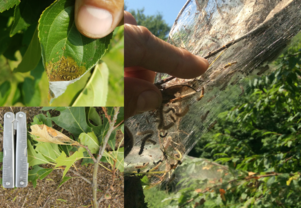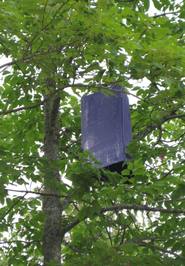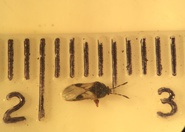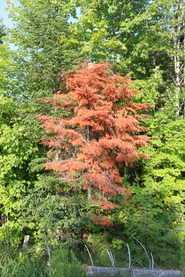Insect & Disease Conditions Update
A printer-friendly
version of this report is available on-line from the Conditions Report Index.
Alder Flea Beetle (Altica ambiens) –
Alder flea beetle continues to cause high levels of defoliation of its hosts, Alnus spp., in parts of the state. This time of year, affected shrubs may only
have crispy, brown remnants of leaves.
The damage may kill individual stems, but this is not considered a significant
pest.
 Browntail Moth (Euproctis
chrysorrhoea) – Browntail
moth eggs are hatching, and the caterpillars have started to skeletonize the
leaves that will later be enclosed in their overwintering webs. Sometimes the feeding activity of fall webworm (Hyphantria cunea) is confused with that of browntail moth. At this time of year, the caterpillars and
webs of fall webworm are huge in comparison to those of browntail moth (see
photos for comparison). Later in the
fall, the fall webworm tents will become tattered and worn, and the webs of
browntail moth will become more tightly woven. Be aware that the cocoons of
browntail moth that were formed on trees and shrubs are still present and
contact with them could result in exposure to the toxic hairs.
Photos: Development of browntail moth caterpillars and early webbing
(left). Development of fall webworm
caterpillars and webs (right). Photos
from southern Maine, week of 8/6/2018, Maine Forest Service.
|
Elongate Hemlock Scale (Fiorinia externa)
– Mobile stages of this
pest are still present, so there is still high risk of spreading scale on
clothing and machinery. If you wait
until after a hard frost for forest management and pruning activities, you will
minimize risk of spreading this pest.
 Emerald
Ash Borer (Agrilus planipennis) – After allowing for public input and
completion of the mid-season check of traps, an order to stop movement of ash
material from towns with detections of emerald ash borer (EAB) in Maine was put
into place last week. The order covers
the towns of Frenchville, Grand Isle and Madawaska. These are the only towns in Maine with
confirmed detections of EAB. More
information about emerald ash borer and the department response can be found at
www.maine.gov/eab.
The
public is invited to an informational session on EAB on August 23rd
at 6:30 pm at the Frenchville Community Center.
Department of Agriculture, Conservation and Forestry (DACF), USDA Animal
and Plant Health Inspection Service and USDA Forest Service staff will be at
the meeting to provide an update on EAB and respond to questions.
Photo: Purple traps similar to the one above captured single
adult emerald ash borers in each of two locations in Grand Isle, Aroostook
County.
We have
recently finished a mid-season check on the purple traps hung to monitor for EAB. Approximately 250 traps were hung by DACF
throughout the state. Over 100 of those
were hung in northern Maine in the vicinity of the recent EAB find in
Madawaska. Three traps in the town of
Madawaska caught EAB, and a single EAB was caught in each of two traps in the
adjacent town of Grand Isle (which was not previously known to contain
EAB). The
USDA APHIS contractor, Delta 21, is checking an additional 411 traps in the
area within 100 miles of the quarantine in New Hampshire (DACF did not hang
traps in that area). No EAB has yet been found in
any other part of the state.
We are also monitoring for EAB using
biosurveillance with Cerceris fumipennis
in the southern part of the state where this non-stinging wasp is found. No EAB have been found so far. If you find
any colonies of wasps (often found on baseball diamonds) you think may be Cerceris
fumipennis, please contact us and we will check them out. We are always on
the lookout for new colonies of this wasp to help us monitor for EAB and other
exotic metallic woodboring beetles.
We have been seeing a lot of declining ash,
both as whole stands and as individual trees, throughout the state for several
years. With the recent years of drought,
the decline seems to have intensified.
We see many ash with all the classical symptoms of EAB: decline and branch death from the top down,
epicormic growth, woodpecker feeding and bark splitting. It is very difficult to differentiate this
from EAB, and often the only way to be certain is to girdle tree in the spring for
use as a trap tree that EAB will be attracted to and then peel it the following
winter to look for signs of EAB. If you
have declining ash on your property and think you might want to participate in
our girdled trap tree program next spring, please email patti.roberts@maine.gov
and ask to be put on our mailing list or call (207) 287-2431.
|
Hemlock
Woolly Adelgid (Adelges tsugae) – Towards
the beginning of August, hemlock woolly adelgid (HWA) crawlers settle at the bases of
hemlock needles and are attached to them for the next six months or more.
During the fall and winter, adelgid cannot be spread except on rooted hosts, so
this is an ideal time to conduct forest management and pruning activities in
hemlock. If your hemlock has HWA,
carrying out these activities now will reduce the spread of HWA to other
areas. If your trees are not yet
infested, working in them now will minimize the chance that you or someone you
hire will inadvertently move crawlers into your uninfested trees. Remember that HWA does not mate, so it
potentially takes only a single crawler brought into your trees to start a new
infestation.

Minute Pirate Bug
(Orius spp.) – Minute
pirate bugs (some of which are also called insidious flower bugs), are very
small insects in the true bug family.
They are very important predators on a wide variety of garden and tree
pests, including aphids, thrips, whiteflies, spider mites, small caterpillars
and many other small insects and insect eggs.
Most of the year, they are scattered throughout your yard and fields and
one rarely sees them. However, in states
to the south and west of Maine, they are known to congregate in very large
numbers near houses and buildings in the late summer/early fall. In past years we have not received questions
about this behavior, but during the last few weeks, we have had several calls
about swarms of this insect. We may be
seeing this behavior now because of the hot, dry weather we have had recently.
Photo: Beneficial minute pirate bugs have been reported in large numbers this year (metric ruler). Photo: Maine Forest Service
Minute pirate bugs do sometimes ‘bite’, probing
your skin with their stylets. It is
thought they do this to ‘taste’ their environment. They do not inject any venom, and most people
just feel a small pinching sensation (although a few can experience swelling
and itching similar to a mosquito bite).
It is important to note that standard insect repellents do not work to
keep minute pirate bugs off your skin or structures. If you find yourself being bitten, covering
up with long-sleeves and pants is your best defense. We do not recommend any chemical control as
these insects provide very important natural control for a wide variety of yard,
garden and tree pests. As the weather
gets cooler in the autumn, they will disappear and again become
unnoticeable.
|
Winter Moth (Operophtera
brumata) – Winter moth, the invasive caterpillar from Europe, has continued
to spread along the coast. Pupae are currently in the soil beneath defoliated
trees and shrubs. These pupae remain in the soil until adults emerge beginning
in November. Much of the movement and spread of this insect is due to people
moving soil containing pupae. Movement
of soil and plantings from infested areas should be avoided.
However, we have good news regarding this pest. For the past few years we have been releasing
Cyzenis albicans, a parasitic fly, to
control winter moth. This year, for the
first time ever, we have recovered the parasite from Vinalhaven and Peaks
Island. We continue to find flies at our
release site in Cape Elizabeth, where the parasitism rate is now up to
20%. This means that the parasite is very
well established and should spread throughout the area. We will continue to release C. albicans when it is available. This
biocontrol program is funded by USDA and coordinated by the Elkinton Lab at the
University of Massachusetts, Amherst.
Soil-dwelling insect predators are also crucial to the control of winter
moth; Cyzenis alone has no chance of
controlling this pest. This is a strong
argument for applying the least toxic lawn care solutions – those that do not include broadcast use of
broad-spectrum insecticides.

Balsam fir mortality Reports
of dieback and mortality of balsam fir have been frequent across Maine in
2018. This seems to be a regional phenomenon with reports from New
Brunswick of wider-spread balsam fir mortality and some similar observations in
the northern areas of New Hampshire and Vermont. Inspection of trees in
multiple areas of Maine have revealed a number of contributing factors to decline and mortality. These include
salt exposure along roads, bark beetle attack, armillaria root
disease/shoestring rot and winter desiccation. As an example, during a recent
trip to Aroostook County nearly all inspected trees in various states of
decline were infested with a tiny bark beetle (Pityokteines sparsus). As
these are all contributing factors
to decline, it is important to consider the source of primary
stress. Due to the lack of precipitation from the later part of last
year’s growing season and the state-wide drought conditions of this year,
drought stress seems to be the major primary
source of stress leading to heightened balsam fir susceptibility to various
other agents of decline.
Drought stress in trees describes a condition where there is not
adequate moisture in the soil for a tree to extract and carry out necessary life
functions. Among other physiological responses, drought conditions can lead to
dieback of a tree’s fine roots that are very important for water and nutrient
uptake. Losing the function of these roots leads to reduced tree vigor,
making trees less resilient to additional stressors. For example, when a tree
suffers drought stress and fine root damage occurs late in a growing season, it
becomes more susceptible to winter desiccation. Also, attack by diseases and
insects are often more damaging to trees during times of drought, since the
trees lack resources for normal defense responses. In some cases, it has
been noticed that even usually weakly pathogenic fungi (those that typically do
not cause disease-like symptoms) have caused cankering and branch dieback in
drought stressed trees. This further highlights the significance of
regional drought as a primary source of stress predisposing trees to attack by
insects and pathogens and reducing a tree’s ability to withstand pressures from
additional agents of tree decline.
The Maine Forest Service will continue to look into balsam fir
mortality to gain a better understanding of this phenomenon.
|
Drought stress and hardwoods – As mentioned in the previous section, prolonged periods of drought during
the growing season have occurred during the past three years. The accumulation
of this drought stress has been increasingly impacting many trees statewide and
may continue to affect trees in the years to come. Conifers, in general, are better equipped to
deal with drought compared to broadleaved trees. However, when conifers suffer from drought
stress and attack from secondary pests, they die seemingly quickly and turn a
bright orange color, making them difficult not
to notice. Hardwoods, on the other hand, decline in various, less obvious ways
depending on the degree of drought and the drought tolerance of a particular
broadleaf tree species.
All tree species struggle to carry out photosynthesis during
times of drought, slowing growth significantly and limiting the production of
chemicals used in tree defense against insects and pathogens. Some tree species
may show scorching of leaf tissue on the leaf margin, while other species may
drop their leaves from a portion of a crown or even the whole tree. Leaves may also become chlorotic (yellow)
since the tree lacks resources to replenish chlorophyll. Branch dieback,
typically in a top downward progression is common following prolonged drought
and loss of leaves. As ash trees are particularly susceptible to drought, this
can be mistaken as a symptom of emerald ash borer infestation. Norway and sugar maples also do not cope well
with drought and often show dieback in the crown. Beech and birch are also very sensitive to
drought and are easily predisposed to attack by secondary agents of decline.
For hardwoods, these include diseases such as Armillaria/shoestring rot and
bark beetles (different species than those attacking conifers) cytospora canker
and some species become more susceptible to verticillium wilt.
Trees will continue to react to this stress in the coming years, so it is
important to monitor the health of your trees and forests. When and where possible, efforts to support
tree health like fall watering and supplemental fertilizer in early spring are
important to helping trees recover from drought stress and some of its impacts.
 Fire blight (Erwinia amylovora) – Fire
blight is a bacterial blight of trees and shrubs in the Rose family (Rosacea). Trees in Maine most commonly affected by this
disease are pear, apple, hawthorn and mountain ash (pictured). On a recent trip to Aroostook County, fire
blight on mountain ash was observed multiple times in several towns. Additionally, samples were received at the lab
from southern parts of Maine earlier this year as well.
Photo: Mountain ash with fire blight. Maine Forest Service.
Fire blight symptoms include quite
rapid wilting and darkening of branch tips resulting in a characteristic ‘shepherd’s
crook’ shape. Soaked-looking, sometimes oozing cankers can be found at the base
of symptoms, while other, smaller cankers may be difficult to recognize. Bacterial
ooze is the main mode of spreading infection to other parts of the same tree or
nearby trees. Spread can occur by rainsplash during warm and moist weather. Insects
attracted to the sugary bacterial ooze exuded from cankers also effectively
spread this disease. Injuries from hail, pruning or other damage can cause
rapid spread of this destructive disease.
Managing fire blight is challenging and a topic of debate. Management guidelines for fruit growers can
be readily found online, but for the homeowner wishing to keep their planting
free of this disease, vigilance and early detection are key. Infected plant parts should be pruned away
and destroyed. Pruning cuts should be
made as far back as possible into older wood, which may harbor the disease, but
will not show symptoms – more succulent wood is much more susceptible. Once fire blight really gets started in a
tree, it may require so much pruning that the tree will no longer be
aesthetically acceptable, stressing the importance of keeping a close eye on
your trees.
|

White pine needle disease evaluation and monitoring project 2018
field work completed – Field work for the Maine portion of a regional effort by ME, MA,
NH, RI and VT to address white pine health issues concluded in early July. The project, titled “Monitoring eastern white
pine decline and its causes in New England and New York through enhanced survey
methods” was financially supported through a grant by the US Forest Service.
Map: White pine needle diseases study sites.
Eastern white pine (EWP) stands with differing levels of symptom
severity were evaluated to determine the stand factors associated with WPND
incidence and severity and assess the impact that this long-term disease
pressure has had on EWP decline and regeneration. The ultimate goal of this
work is to use what is learned to develop management practices to improve EWP
health in Maine and the overall region. A total of 40 plots (each with 4
subplots) and approximately 700 trees were evaluated by Maine Forest Service
Forest Health personnel across the state’s most concentrated white pine resource.
Trees were evaluated based on crown health variables such as transparency,
density, live crown ratio and disease presence. Other site factors like slope,
aspect, basal area, etc., were also recorded. Additionally, diseased needle
samples were collected to be identified by a USFS forest pathologist.
Currently, data is being entered and will be analyzed this fall/winter with a
publication of results is planned for 2019.
Special thanks to all the landowners, managers and foresters who
helped this effort and offered their white pine land for our work. Supporters
include the University of Maine Demeritt Forest,
Maine Bureau of Parks and Lands, Maine Inland Fisheries and Wildlife, Maine
Forest Service-- Forest Policy & Management Division, the US Forest Service
for use of the Penobscot and Massabesic research forests, Chadbourne Tree Farms,
Freeman Ridge Forestry, Hancock Lumber, JD Irving, LandVest, Robbins Lumber and
Sappi.
|
August 23, 6:30PM: Emerald Ash Borer Informational Meeting. Frenchville Community Center, Frenchville,
ME.
Sept 8: Annual
Forestry Field Day. Wilton, ME. Colleen
Teerling will be on hand to provide information about forest health
topics. http://www.mainewoodlandowners.org/Events/ForestryFieldDay.aspx
September 21, 22, 23: Emerald
ash borer information will be available in the Native Arts and Crafts
Tent. Sept 22 @ 10:00 am Colleen
Teerling will present a talk on emerald ash borer. The Maine Forest Service
will have information on other topics at the Pine Gate.
Office
hours are 7:30 a.m. to 4:00 p.m., Monday through
Friday, except for holidays. If you plan to visit either office, you may wish
to call ahead just to make sure someone will be present to meet with you. (207)
287-2431 (Augusta) and 827-1813 (Old Town)
Conditions
Report No. 3, 2018
On-line:
http://maine.gov/dacf/mfs/publications/condition_reports.html
Department of Agriculture Conservation & Forestry
Maine
Forest Service - Forest Health and Monitoring
Contributors: Aaron Bergdahl, Allison Kanoti and
Colleen Teerling
|